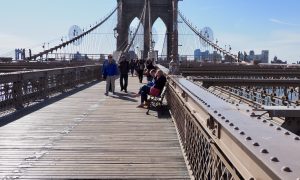When we drove into Buenos Aires the words to the song “Don’t cry for me Argentina” resonated in my head. It wasn’t hard to feel the presence of this city’s most famous resident, Eva Peron.
Even though she died over 60 years ago, Evita is still a big deal in Argentina. I realized this when her profile on the top of a tall building in the center city came into view reminding me of the building with Che Guevara’s profile on the side in Havana, Cuba.

Having the diminutive powerhouse looking over the sky line screams power and influence to me.
My only knowledge of her was the movie starting Madonna and the Broadway musical by Frank Lloyd Weber and Tim Rice .
Seeing her figure so prominently on the building made me want to learn more.
The New York Times describes her as ambitious, ruthless, untiring, clever and strikingly beautiful. Some call her a megalomanic while others see her as a saint.
There’s even a museum devoted to her life. Unfortunately the photos I took there were lost when my camera was stolen in Buenos Aires, so will have to make do with Internet images from the museum’s web site.
The museum, housed in an old mansion once set up by the Eva Person Foundation for homeless women, was not particularly sophisticated. I thought it was just one step above hand lettered signage, but it told the story of the woman who rose to great celebrity and power in very short order during a time of great chaos in this South American city.
Being a former fashion writer I found the part of the museum with her clothes particularly telling. Evidently clothing were her costumes, reflecting her priorities and the roles she played in her life.
She grew up illegitimate in a small town in Argentina. Her mother was the mistress of a well known business man. Her clothing reflected the poverty. She wore simple peasant garments.
She got herself to Buenos Aires as a young woman and over several years became an actress and radio personality, wearing very flamboyant attention getting attire. Some might say vulgar.
It was then that she caught the attention of military leader, Juan Peron, becoming his companion and eventually his wife. He became president of Argentina. As First Lady of the county, she transitioned to high fashion, European styles. One can see her designer clothing, tailored suits and eye catching jewelry on display.
But as her interests turned to helping the poor of her country and promoting rights of women, she chose dark simple suits and dresses and wore her hair in severe styles.
Evita died of cancer after 7 years of prominence and power. One can’t help but wonder if she had lived what life would have been like. I repeatedly asked guides in Buenos Aires about her, getting mixed reactions. The most interesting comment to me was that while the people may love or revile her, they appreciated and valued her many humanitarian efforts.
Below are two images I captured on the trip. First is her grave in the cemetery in Recoletta, the northern part of Buenos Aires. We were told it is the most visited spot in this popular tourist destination. The second is her likeness on a balcony in the creative artsy part of town known as La Boca. Again, Evita is looking down over the crowd. I think this is the way the Argentine people imagine her.

She’s truly an enigmatic figure in the history of Argentina.













Comments
1 CommentPeggy DePersia
Apr 16, 2018It is always fascinating how individuals develop power and influence and once they have it, how they use it. I’m imagining that the messages about Eva Peron will remain ‘mixed’.